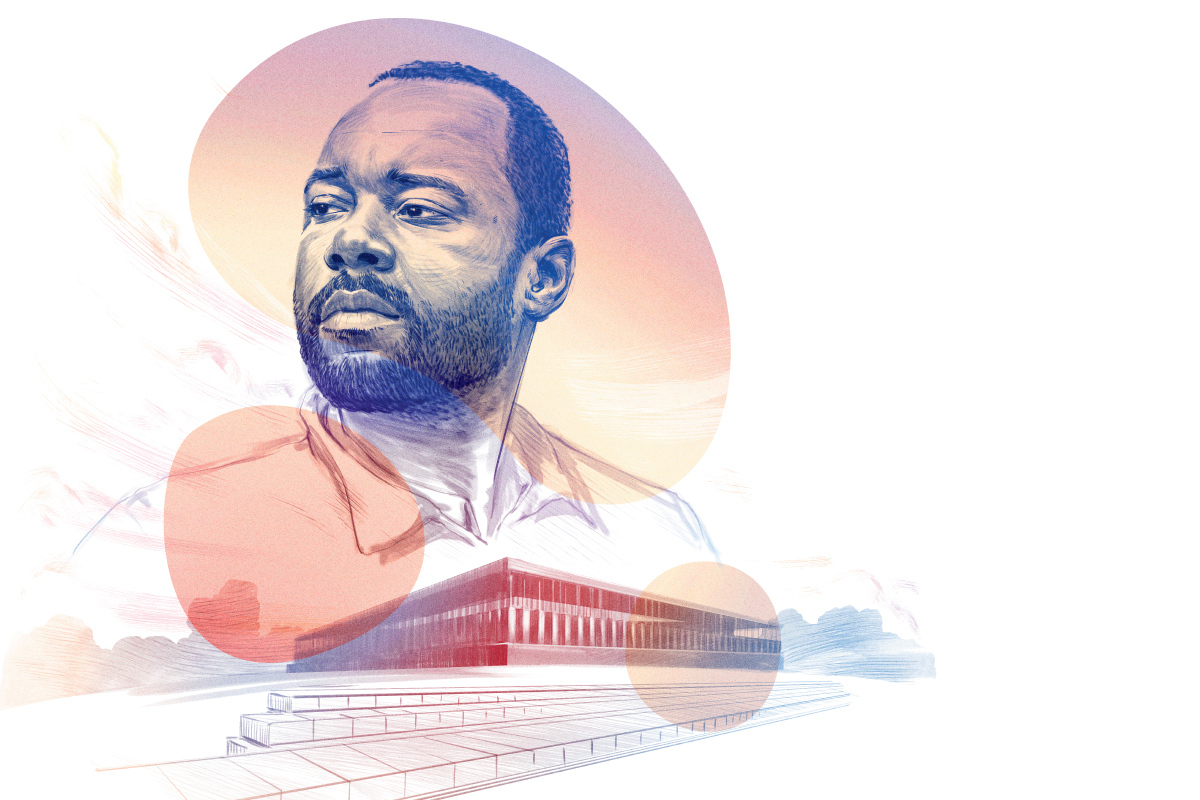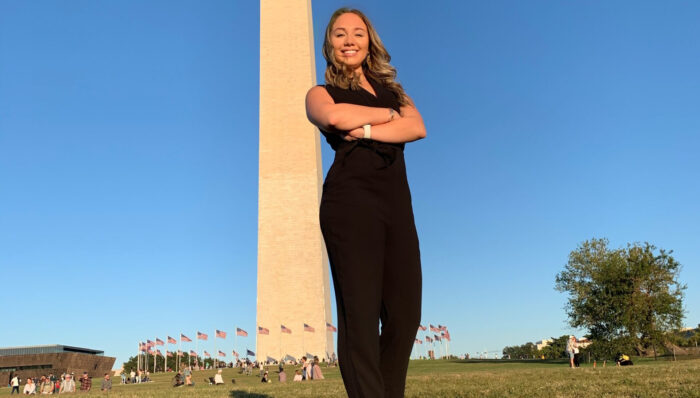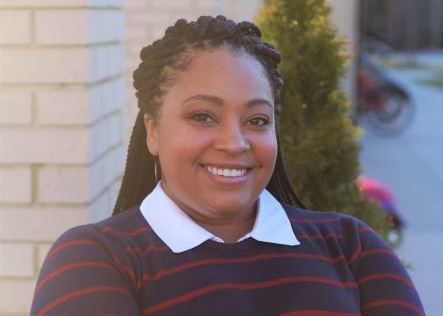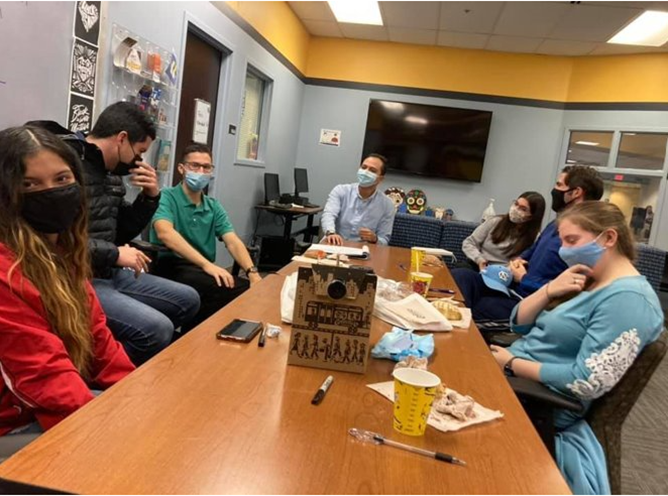A Marquette professor and son of Memphis, Tennessee, leads a group from Marquette on a pilgrimage to sites from civil rights history that still have volumes to say today.
In April 2018, Dr. Cedric Burrows saw a segment on CBS’ 60 Minutes in which criminal justice attorney Bryan Stevenson gave Oprah Winfrey a tour of his latest project, the National Memorial for Peace and Justice in Montgomery, Alabama.
The site honors the thousands of victims of racially motivated lynchings in the United States. And it does so in a breathtaking way, with 800 human-sized blocks of rusted steel dangling from the ceiling of an open-sided structure, each block representing a county where lynchings occurred.
Watching the report in Milwaukee, Burrows, an associate professor in Marquette’s English Department, heard Stevenson speak of lives snuffed out by mobs, of people such as Reverend T. A. Allen who angered plantation owners in Hernando, Mississippi, in 1935 by organizing sharecroppers. In his suit pocket when he died, said Stevenson, was a pamphlet about sharecroppers’ rights and a note that said, “Every man a king.”
“He just wanted to be respected as a human being, and that got him hanged,” said Stevenson, a MacArthur genius grant recipient whose organization, the Equal Justice Initiative, has conducted a comprehensive review of records related to lynchings.
Burrows was moved. “For me, it was the whole idea of having a monument to these forgotten lives — that somebody researched these people and wanted to memorialize them.” By the time the clicking stopwatch marked the end of the CBS report, he was making travel plans. Within a week, Burrows was in Montgomery, experiencing the new memorial. While in Alabama, he spent time at other sites too: the church where Dr. Martin Luther King, Jr., organized a boycott of Montgomery’s segregated bus system; the Edmund Pettis Bridge in Selma where future Congressman John Lewis and other protesters were beaten while marching in support of Black voting rights; and others.
In traveling south, Burrows was continuing something that started when he was a young child — in moments like a family trip to Atlanta when his father pointed out King’s grave. A few years later, when his class took a field trip to an Underground Railroad site in Memphis, Tennessee, the bus passed Forrest Park where someone pointed out a statue of Nathan Bedford Forrest, a founder of the Ku Klux Klan. Over a few hours, Burrows was confronted with two cultural currents coursing through his hometown, one memorializing efforts to secure Black people their freedom and another recognizing efforts to deny them their rights and terrorize them.
Over the years, Burrows stayed attuned to symbols and narratives like these. By the time he moved from graduate study to a career in academia, exploring them had become a cornerstone of his scholarship and teaching. In recent years, that’s made his voice an influential one. At Marquette, he’s redesigned an English course to focus on the quest for racial justice and its expression in language — and been recognized by President Michael R. Lovell as a Marquette Difference Maker for it (with colleague Dr. Lilly Campbell). His 2020 book, Rhetorical Crossover, received the National Council of Teachers of English’s highest honor for scholarship, the David H. Russell Award. In its prologue, Burrows describes marveling at the “resilient spirit” he witnessed at the lynching memorial and again encountering divergent narratives on that trip — like the historical markers bearing a city seal that touts Montgomery as both “Cradle of the Confederacy” and “Birthplace of Civil Rights.” The book goes on to trace “dueling narratives about African Americans that percolate through … music, education, film and social movements.”

Last January, Burrows took another trip to civil rights sites in the South, but this time he wasn’t alone. With coordination from Marquette’s Center for Peacemaking and support from an anonymous donor, a diverse group of 15 students and several staff members traveled by bus to many of the sites from Burrows’ 2018 trip, plus others such as the National Civil Rights Museum in the restored Lorraine Motel in Memphis where King was assassinated. It was a seven-day Civil Rights Pilgrimage, a journey together with many opportunities for reflection in the Ignatian tradition.
In places like Glendora, Mississippi, the pilgrims encountered half-century-old history that still felt active. Glendora was where 14-year-old Emmett Till’s beaten body was found in the Tallahatchie River in 1955, tied to a giant fan blade, after he’d been accused of offending a white woman in a nearby grocery store.
Edith Hudson, chief of Marquette’s Police Department, joined the pilgrimage because her mother grew up in Glendora around the time of Till’s death and the subsequent acquittal of his accused murderers. When the group arrived there in January, Hudson was impressed that the current mayor of the town, Johnny Thomas, pulled up to discuss the small museum he personally created to make sure Till’s life and death were properly remembered. More concerning, though, was the condition of the store where Till’s story began, which an owner has refused to sell to preservationists. “It is in such a dilapidated state. There are vines everywhere, and there’s no chance it will ever be preserved,” Hudson reflected in a campus discussion after the trip. “To me, that was powerful in showing how people feel about the racism that occurred. They want to hide it. And they don’t want history to be preserved, so we learn from it.”
The visit to the lynching memorial came on the journey’s fourth day and provided some particularly moving moments. Serina Jamison, Grad ’16, ’22, then a graduate student in English who has since received her master’s, explains how the memorial has visitors slowly descend into the space. “A ramp goes down to the point where the rectangular blocks with the names embedded on them are above you. It gives the sense that you are underneath their hanging bodies,” she recalls. “I had a very visceral reaction … just feeling the gravity of lynching in America and how we don’t talk about it as we should.”
Benjamin Linzy, Grad ’17, a doctoral candidate in history who grew up in Kentucky and has lived in Tennessee and Louisiana, found personal connections in the metal sculptures inscribed with records from the five Southern counties where he’s lived. “Every one of them had at least one lynching,” he recalled in a podcast this spring. “It’s coming face-to-face with this violence and realizing that my ancestors, if not active participants in the violence, were passive participants. … So, it’s a sense of responsibility for the sins of my ancestors.”

Another unforgettable experience came as the group left that memorial and wandered upon another that was nearby. This one was devoted to three enslaved women — Anarcha, Lucy and Betsey — involuntarily used as test subjects in pioneering gynecological research conducted in Alabama. The doctor who operated on the women, J. Marion Sims, is commemorated in a statue near the state Capitol as “the Father of Gynecology.”
As fortune had it, Michelle Browder, the artist who created the colorful 15-foot-high statues honoring these “Mothers of Gynecology” was on site, making minor repairs, when the Marquette group arrived. “My gosh, she was so welcoming. Just amazing,” says Jamison. “She told us her intentions, that she wanted everyone to know that we’ve literally been touched by Black women because without Black women, women today wouldn’t have reproductive health as we know it.”
Burrows says experiences like these hold lessons for the planning of future trips, so that itineraries aren’t packed so tightly with iconic sites that a pilgrimage starts feeling like tourism. “It’s about allowing for these moments,” he says. “When you encounter people with stories to tell, they’re part of a tradition of having narratives that speak about history. It’s one way these become living spaces, how history is never fully in the past.”
Jamison’s moments in Montgomery helped her answer a question posed frequently near the end of retreats or service days at Marquette, one she was asked to consider on the pilgrimage: “Where did you feel God today?”
“That was a very difficult question to answer,” she acknowledges. “There are definitely times when you question, ‘Where was God?’ But in all of this, at least for me, I realize the fact we’re going on this pilgrimage, the fact we know stories of people who fought and intentionally said, ‘I’m going to choose freedom. I’m going to choose my humanity to change something even if I won’t be here to see it.’ That is where God lives.” ¤

Illustrations by Sam Hadley
The next Civil Rights Pilgrimage is planned for spring 2023, but support from donors is needed. To become a supporter, contact Pat Kennelly of the Center for Peacemaking at Patrick.kennelly@marquette.edu.




